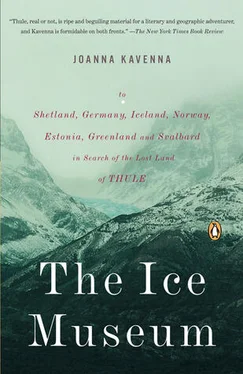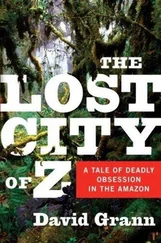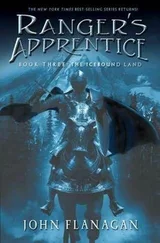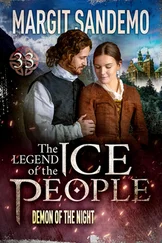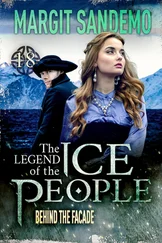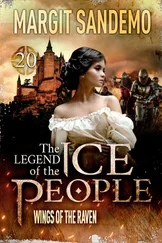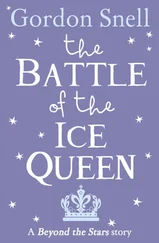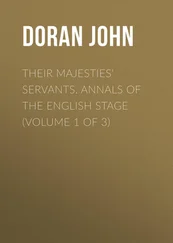Later, we left the camp by the glacier, walking the short distance back to Longyearbyen. The scientists shook hands and waved goodbye, stepping back into their hotels, taking each other for pizzas in the small restaurant shacks. I walked down to the docks. The shore was a field of mist, a few motorboats were stranded there, their decks empty.
On Svalbard the governor reigned benevolent over everybody. The governor’s civil servants, environmental experts, tourism consultants hardly dared breathe when he let his eyes fall on them. It was a place where the rocks were protected, and occasionally mined, depending on what the governor decreed. The governor threw edicts and boundaries across the land, keeping everything plain and empty. The rocks were tagged with rules, enforcing a state of innocence. The island could not be used for the purposes of war: since World War Two, when Svalbard was bombed and occupied by the Germans, all fortifications and naval bases, secret military sites, missile defence systems were prohibited. Much of the land was cordoned off, kept clear of tourists. The unrestricted use of the island, which nearly wiped out the walrus and the reindeer, had been replaced by a system of national parks, plant-protection areas, bird sanctuaries.
The governor was an autocrat with a fat rulebook. He demanded that travellers remain in official tour groups, that they confine their journeys to the appointed tracks. The rules were pasted to the walls of the hotels and bars: ‘Do not disturb animals and birds. Remember, you are a guest. Do not pick flowers. Do not go into the wilderness without asking permission from the Governor. Do not damage or remove cultural monuments. All traces of human activity prior to 1946 are cultural monuments. It is illegal to search for or to attract the attention of polar bears.’ The wilderness was too pristine for random hiking strays to wander across it; the polar bears were too fierce for the uninitiated to set off alone. It was the governor’s request to the visitor to travel with the herd, to stay on the authorized cruises, the authorized helicopters, the authorized buses. The trailblazer was outlawed from these ice islands; the governor would have politely escorted Burton, Nansen or Amundsen off the rocks. Everyone was asked to leave untouched the untouched glacier, to stay in the settlement of Longyearbyen or to take the official tours.
The edicts were so strict that Svalbard became an invented reality, with something slightly odd at its edges. Still, the governor had environmental necessity on his side, sacrificing the interests of humans to the abiding beauty of the rocks. The visitors became obedient subjects, following the governor’s decrees. They had come on their own grail quest, looking for the almost unspoilt and almost empty places of the north, and they hardly wanted to wreck the cold mountains and debauch the fjords. They deferred to the governor, joining him in his enterprise to keep this land pure. For a few days, I relaxed into the forcibly innocent world of Svalbard, innocence decreed by the omnipotent governor. The governor was out of town when I arrived, but I learnt a lot about him. He was the fixed subject of nearly every conversation; half of Longyearbyen loved him like a father, and the other half cavilled violently. Yet they all obeyed him.
Though the governor was trying his best to balance it all, there was little he could do about the creeping processes, the chemical reactions in the atmosphere, the traces of climate change. There was a team of prophets on Svalbard, casting their cards at the future, a regiment of scientists deployed in a small colony called Ny-Ålesund, north of Longyearbyen, north of every other settlement in the world. The scientists were offering up predictions about the coming earth, the warmed earth of the future. They were trying to lasso the indeterminacy of the future, drag it towards the present.
Far below these notables, the resident mine owners seemed to occupy a blank spot in the governor’s vision. There were still mines on Svalbard—Norwegian and Russian-owned, like relics from earlier centuries, when the trappers and the furriers and the whalers swarmed on the beaches, in their blubber camps, or in their huts stacked ceiling-high with hides. The coal companies were still allowed to bang away at the rocks; the governor called it cultural heritage, because there had been coal mines in Svalbard for a long time, but really the coal mines were commerce, old-fashioned exploitation. Svalbard was a rich cold coast: the ice-mountains were seamed with minerals, the rocks filled with coal, gold and diamonds. The history was hardly pretty—the preceding centuries showed a line of determined humans, trappers hiding out in the snowstorms, knives poised, guns ready, miners coming to blast the rocks, piling up dynamite. Armies of pragmatists, hardly interested in old dreams, taking what they could from the islands.
It was late in the season for outings but I persuaded a bony-faced man called Anders to take me to the Russian mine at Barentsburg. Anders was wearing bright orange overalls, like a human beacon on the shore. He moaned as he fumbled with the ropes. ‘I don’t understand why anyone wants to go there,’ he said. ‘It’s a bleak place. Miserable.’ Anders’s boat was a stuttering motor-cruiser, which moved slowly along the fjord, cracking the sludge-ice as it went. The ice churned under the boat, and Anders stood on the bridge, saying how beautiful the winters were, when the mist rose from the fjord sides and the moon gleamed across the ice. He was surly and unkempt, his hair coated in grease, his hands covered in dirt.
‘There’s never a perfect place, but I prefer this place to anywhere else,’ he said, screwing up his eyes to stare at the mist.
Barentsburg was round the corner from Longyearbyen, along a coast of green rocks, covered in ice. There was nothing to see at first. The town was engulfed in thick mist; the quayside was covered with rusty iron containers stacked up in piles, and the skeletal shapes of cranes. Russian workers stood in small groups, talking. Anders ran up the steps from the shore, and found a Russian woman called Natasha who said she had a spare half-hour and could show me a few buildings. Anders was off to buy vodka, he said, and he moved quickly away towards the local shop.
Natasha was neatly dressed in a red jacket, black trousers, small bird-heel shoes, and she seemed to be speaking an official language. Everything she said jarred significantly with the physical evidence around her, but she ignored the discrepancies. She shook my hand; her hand was cold, and she breathed heavily as we walked up the steps to the town. She said: ‘In Soviet times you had to be a member of the Communist Party to come to Barentsburg, but now, it is only necessary to be healthy, to be able to overcome Arctic conditions for two years.’
We passed the piles of steel containers, and Natasha said they were full of coal; in the winter it was impossible to ship anything because of the ice, and the coal was stored on the shore. During the summer it was taken away. We walked past dilapidated wooden houses, standing by the shore, their windows broken. Natasha gestured towards the shattered windows, and said, ‘We keep these buildings to remind us of how things were,’ and then she said, as if that had not quite explained things, ‘We always mean to repair them each summer, but the summers are so short.’ It seemed unlikely they would ever be repaired.
‘You can come here for longer, if you like, and the average stay is eight years,’ Natasha said. ‘There have not been so many changes here since Soviet times, and the conditions are still hazardous. But there are positive benefits, all meals are supplied, and we have a small café for further purchases. But,’ she said, suddenly, ‘you must not look the men in the face, you must not go too close to the people, you must not talk to them.’
Читать дальше
